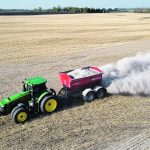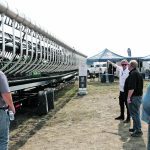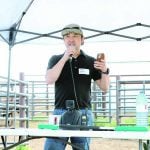With resistance still an elusive research goal, rotation of both crops and fungicides remains the best tool against disease
Identifying and managing diseases is crucial to yield and grain quality. Spraying technology, chemical application and new seed varieties help in the battle for healthy crops, but fungi, bacteria and other microorganisms continuously adapt, becoming resistant to genetic defences and crop protection products. So, what are the latest threats? Green and yellow peas, chickpeas, lentils, […] Read moreStories by Michael Robin

EU loosens rules for new genomic techniques
A recent decision by the European Parliament could open opportunities for crop development and international trade
SASKATOON — A European Parliament decision earlier this month to adopt new rules for what it calls new genomic techniques is good news for agriculture and international trade, say industry and academic experts. “Science has been under a very dark cloud for a long time in Europe, and so now I think we’re seeing those […] Read more
Laptop fix leads to seed company solutions
Cloud-based SeedTrakr system continues to be refined with the input of the businesses that inspired its creation
Sometimes the idea for a new product literally walks through the door. “So once upon a time Ron Jefferies, who I knew from curling and as a neighbour and things like that, wanders into my office with a broken laptop,” said Bill Rimmer. “He said, ‘can you help me with this laptop?’” Rimmer is managing […] Read more
Taking a close look from a long distance
Satellite data and machine learning are yielding powerful tools for crop management in Western Canada
SASKATOON — Information is power, and by putting that power into farmers’ hands, Steve Shirtliffe wants to help Western Canada continue its record of world-leading innovation. “My vision is that we build a digital agriculture economy here in Saskatchewan,” he said. “ We’ve done it before. Where did no till come from? Where did people […] Read more
A little less acid can boost crop nutrition
Altering soil pH may reduce fertilizer needs by reclaiming residual nutrients and increasing use efficiency
SASKATOON — With farmers in Western Canada facing another year of expensive crop inputs, a soil amendment that helps cut these costs by using what’s already there could be attractive. “We’ve been over-fertilizing for 50 years,” said Morgan Duggan, sales agronomist with NorStar Agriculture, which specializes in amendments to deal with pH, salinity, toxicity and […] Read more
Increasing flax yields faces genetic challenges
Researchers who want to optimize flax for seed production must backtrack on 8,000 years of agricultural development
SASKATOON — When Bunyamin Tar’an introduced a new flax variety, CDC Esme, to an audience of farmers, the question from the floor was immediate: what about the straw? “Similar to (CDC) Glas,” he said. “Almost all the plants have similar structure. A lot of the challenge with flax is that the straw is really, really […] Read more
Flying the fields

Fast, accurate variety confirmation

Airbar keeps stray crop in the hopper
Air-assisted harvesting system is designed to deliver more bushels for a quick return on producers’ investment
A hollow metal tube with regularly spaced long, curved metal tines hangs over the combine header like a weird hybrid of a hay rake and harvester. Tubes lead behind the header to a powerful blower assembly, hinting at what the S3 AWS Airbar FDX rig is all about: using air to shepherd crop into the […] Read more
Hybrid rye silage offers crop options
Fall-seeded crop is good at making the most of seasonal moisture and then leaves the field available for planting barley
Livestock producers chasing moisture for their forage crops could benefit from taking a look at hybrid fall rye, according to researchers at the University of Saskatchewan. “It seems to me that we are seeing different weather patterns,” said Greg Penner. “I can’t say they’re predictable, but in some years we get a fall moisture event […] Read more



